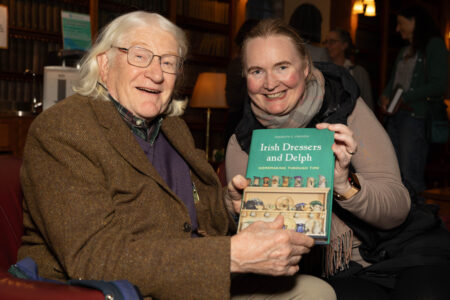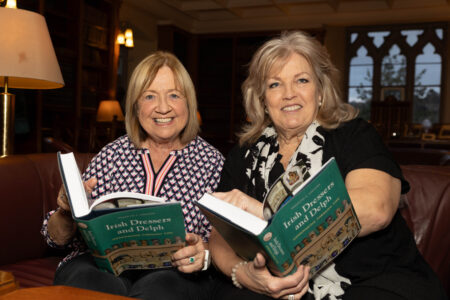4 November 2025
By Bryan McCarthy
bryan@TheCork.ie
What changes a house into a home? New book explores the art of homemaking through Irish dressers and delph with a focus on west of Ireland
“Irish Dressers and Delph: Homemaking Through Time”, a new book by Professor Meredith S. Chesson, explores how kitchen dressers and delph can teach us about our past, and help people transform their house into a home in the past and today. The book describes how people living in coastal areas of Counties Galway and Mayo, including three islands off the west coast of Ireland, used their dressers and delph collections to craft meaningful lives over the last two centuries, and how their dressers and delph connected one generation to the next.

Author Cormac O’Malley, NYU and dr. Miriam Nyhan, MIC Limerick at the launch of a new book published by Cork University Press “Irish Dressers and Delph: Homemaking Through Time” by Professor Meredith S. Chesson in UCC.
Photo Darragh Kane

Colette Jordan, Wilton and Author Rachael Linton at the launch of a new book published by Cork University Press “Irish Dressers and Delph: Homemaking Through Time” by Professor Meredith S. Chesson in UCC.
Photo Darragh Kane
An archaeologist based at the University of Notre Dame in the United States, Professor Chesson has been travelling to the western islands of Inishbofin, Inishturk and Inishark and mainland towns of Clifden and Cashel since 2011, researching, excavating, examining and cataloguing dressers and delph and conducting interviews with locals about their family heirlooms. In this research, she has catalogued more than 1600 objects and 21 dressers. Her interest in Irish dressers and delph was sparked after calling into friends’ homes on Inishbofin while she was conducting archaeological research on Inishark.
Speaking ahead of the book’s official launch this week, Professor Chesson said: “As an archaeologist, my work focuses on investigating how people transform their houses into proper homes, and in particular the belongings with which they surround themselves to tell their own individual and family stories.
“I know that dressers and the belongings they display have held a very special place in Irish homes for generations and still are cherished in homes throughout the country. At first glance, the dresser’s job is simply to store possessions – including delph, holy water, family heirlooms, money, and travel souvenirs. Focusing on coastal and island communities in the west of Ireland however, the book explores the deeper role that dressers have played – anchoring homes, protecting the memories of loved ones who have passed or emigrated, and connecting people through space and time by telling stories of personal histories and social memories.”
Dressers and delph recount microhistories of owners, families and communities
Speaking further, Professor Chesson said: “The dressers the book documents, like the delph and possessions they hold within, tell stories that paint a social, economic and political picture of the communities in which they are found.
“Historically, there has been a common misperception that the communities on Ireland’s western islands were somewhat too impoverished or behind-the-times in terms of fashion to purchase furnishings and decorate their homes. Through my research I discovered that the dressers and delph being collected as heirlooms and valuable items were often the same brands and styles as ones kept in larger cities and towns. These consumer goods were making their way to the farthest reaches of Ireland to allow people to engage in homemaking practices and to display the latest styles in their homes. The islanders and people living in the west were making aesthetic decisions about their homes in the same way that those in urban areas were – strongly refuting that image of islanders as being uncultured or marginalised.
“The dressers also index the traditional gender roles of these communities down through the years – the traditional contribution of men as boatwrights and carpenters making the dressers, and the contribution of women as the orchestrators of the home, whose job it was to keep the dresser. Likewise, the postcards, letters and souvenirs stored in the dressers highlight the well documented stories of emigration, migrant labour, and connections across the region.”
“The book recounts personal stories that readers will connect to – for example one interviewee shared with me how to this day she eats off the same 1950s plate every morning. It was her father’s favourite plate, so she ‘has breakfast with her father every morning’. One tureen we documented was lovingly referred to as ‘The Bank’ by one family, as the mother in that home had stored her purse there and sent her children to ‘The Bank’ when she needed to do the shopping.”
“The overarching theme in the book is that Irish dressers turn houses into homes by weaving together the tangible and intangible aspects of a family’s and a community’s history.”
Describing the research process to show readers how they can research their homes
According to Professor Chesson, the book also can serve as a guide for anyone who may be interested in undertaking anthropological projects to document their own personal and local stories. “This book is intended for people with an interest in Irish history, archaeology, architecture, antiques and folklore. It details the processes we used to conduct our archival and material culture research so that people can enhance their own skills and conduct similar projects to identify and preserve the homemaking practices in their local communities.”
Irish Dressers and Delph: Homemaking Through Time is published by Cork University Press and available online and in bookshops throughout Ireland.
Events to officially launch the book will take place in Cork and in County Galway on the following dates:
· 21st October: Staff Common Room, University College Cork, 6pm.
· 23rd October: Inishbofin Community Centre, 3.30pm.
· 24th October: The Clifden Bookshop at 3pm.
For further information on the book, visit here.
To find out more about Professor Chesson and her colleagues’ research into the tangible histories of Inishbofin, Inishturk and Inishark, visit: https://www.archaeologyirishislands.org/
